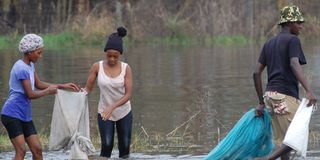Fish and humans at risk as lakes harbour toxic metals

Residents of Barut living near Lake Nakuru National Park fish in flood waters on July 8 after the lake burst its banks. Experts have warned that lakes Nakuru and Naivasha contain high amounts of toxic heavy metals.
What you need to know:
- A study commissioned after fishermen complained of fish that were decaying at an abnormal rate
- He said Lake Naivasha, being a fresh water lake, has pH levels of between 6 and 8, but pollution had led to acidification that has seen its Ph levels drop to below 6.
Researchers have warned of the presence of heavy and toxic metals in lakes Nakuru and Naivasha.
A study commissioned after fishermen complained of fish that were decaying at an abnormal rate and had a strange discolouration established that the lakes were heavily polluted.
PhD scholar Jackson Kinyanjui from the Agro-Climatologist Graduate School of Chinese Academy of Agricultural Sciences (GSCAAS), in an interview with the Nation, said the recent flooding led to unmonitored inflows from various sources.
He said Lake Naivasha, being a fresh water lake, has pH levels of between 6 and 8, but pollution had led to acidification that has seen its Ph levels drop to below 6.
He added that another issue was the destruction of fish breeding grounds: “This has led to competition for food and breeding grounds.”
Sources of pollution
The scientist warned that if this goes unmonitored, the extinction of the remaining fish species in Lake Naivasha was imminent. A recent inspection report by National Environment Management Authority (Nema) officials Ann Owino, Shieni Koiyet, Jessica Kahura and Caroline Muriuki recommended the formation of a multi-agency team to undertake water, sediments and fish quality analysis along the lake shoreline.
They stated that the rising water levels have submerged several facilities next to the lakes which are major sources of pollution.
“In order to safeguard human lives, there is a need to conduct water and fish quality analysis even as the unpredictable phenomenon continues,” the report reads.
Following this report, Nema formed a technical team comprising experts from the Kenya Marine and Fisheries Research Institute (KMFRI), the department of fisheries and the Water Resources Authority (WRA) to investigate.
Unregulated fishing
The team noted that more time was required to secure data relevant to the research, with the KMFRI team currently collecting water and fish samples from designated sampling points. The researchers also raised concerns over unregulated fishing in Lake Nakuru.
They said the lake waters have been polluted by raw sewage from the sewage treatment plant, which has now been partially submerged by the swollen lake.
The researchers called for the proper maintenance of the sewage treatment works including disposal of sludge solids in ways that do not leach toxic metals into Lake Nakuru. They also called for the controlled leaching of toxic materials from former hazardous waste sites in the watershed.
The assessment was a follow-up to joint investigations carried out in February by KMFRI and the Kenya Wildlife Service (KWS) on the causes of fish die-offs.





